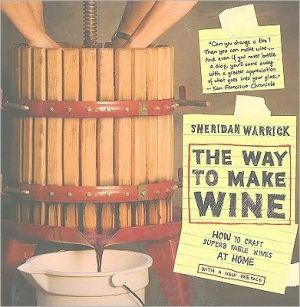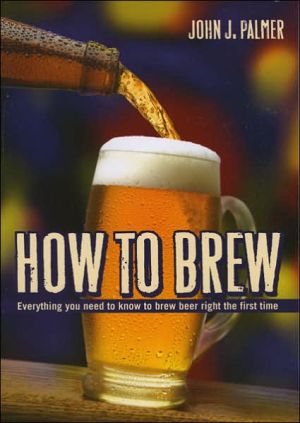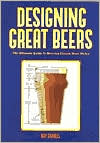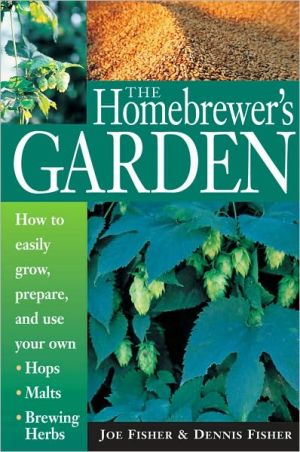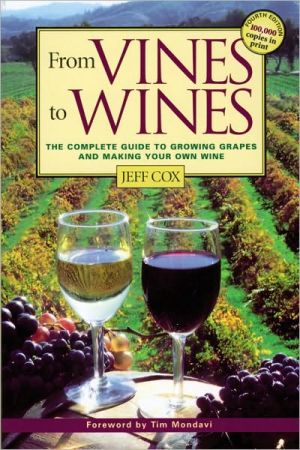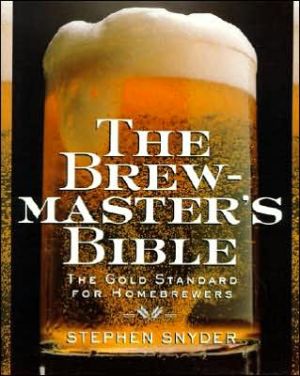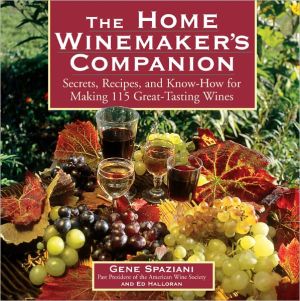The Way to Make Wine: How to Craft Superb Table Wines at Home
Written by a vintner and science editor with twenty-five years experience, The Way to Make Wine is the most readable and reliable handbook among the many winemaking guides.\ In engaging conversational prose, Sheridan Warrick shows that making your own wine is not only easy, but also fun. Geared to everyday wine lovers who want to drink well, save money, and impress their friends, this book reveals everything needed to make delicious wines—both reds and whites—from start to finish.\ Warrick...
Search in google:
"An essential reference that takes you step-by-step through techniques used by professionals to create quality small-lot wines. A book like this would have been a huge help for me when I first started making wine! Both easy to read and serious enough so that the reader doesn't feel talked down to as an amateur, The Way to Make Wine is a much needed guide to the basics of modern winemaking."—Michael Dashe, owner and winemaker, Dashe Cellars"This book is a terrific resource. Warrick clearly knows his stuff and conveys the sometimes technical information in a truly palatable manner."—Lynn Alley, frequent contributor to Wine Spectator and author of Lost Arts: A Celebration of Culinary Tradition Library Journal The Way To Make Wine is a concise and readable handbook by Warrick, a Northern California winemaker and magazine editor. Focusing on dry table wines, he demystifies winemaking for the amateur vintner with informative chapters on equipping a home winery, supplies needed (grapes, wine yeast), and fermentation. Chapters are laid out in a logical sequence along with sidebars offering good tips. A step-by-step recap of the winemaking process detailed in previous chapters is an added bonus as are the checklists and tables. A list of suppliers and laboratories and a short bibliography are included. Recommended for academic and medium to large public libraries. Christine Holmes, San Jose State Univ. Lib., CA Copyright 2006 Reed Business Information.
The Way to Make Wine\ How to craft superb table wines at home \ \ By Sheridan F. Warrick \ University of California Press\ Copyright © 2006 Sheridan Warrick\ All right reserved.\ ISBN: 0-520-24719-1 \ \ \ \ Chapter One\ GRAPES AND OTHER INGREDIENTS \ There's more than one way to get started in winemaking. Consider my friend who, on a picnic outing with pals in the Napa Valley, pulled up beside a tractor hauling a trailer full of grapes. He poked his head out the window. "Got any for us?" he yelled. The tractor driver waved an arm. "Still some out in that vineyard," he said. "If you want 'em, help yourself." The surprised picnickers laughed, but in minutes they were on their knees beside the dusty vines, hacking with pocketknives at the clusters of grapes. Hours later, with a few hundred pounds of fruit in the trunk, they sobered up. "We didn't have the slightest idea what to do with it all," my friend says. He called the owner of a beer-brewing shop and begged for a rundown.\ That was 30 years ago. He now owns a vineyard in Washington State and runs a business selling grapes to home winemakers around the country. He has since made many remarkable wines but swears the Zinfandel from those first grapes-which they crushed themselves that night-could hold its own against any of them.\ THE GLORY THAT IS GRAPES\ In other words, making good wineyour first time out, or your seventh, is not such a difficult trick. The key thing is to find good grapes. That doesn't mean you have to haunt the Napa Valley hoping you'll bump into a generous grower. It does mean that before you start rearranging your garage or investing in equipment, you'll want to know what grapes you'll begin with. Put aside for now the choice between Zinfandel and Cabernet, Chardonnay and Sauvignon Blanc. Here's a rundown on some more basic options.\ Fresh fruit. Grapes right off the vine are the gold standard of winemaking. The most desirable varieties are in the species Vitis vinifera, the European wine grape. Unlike other grapes and virtually all other fruit, vinifera grapes ripen to have an ideal mix of sugar, acid, and flavor compounds. What you get, after fermentation, is wonderfully balanced wine with enough alcohol to stay fresh-tasting and stable for months and even years. What's more, the many varieties of European wine grapes have for centuries been bred and selected to differ in remarkable ways-some ripening earlier, some later; some producing wines with exceptionally deep color, or extra acid, or stronger fruity or floral aromas. Cabernet Sauvignon, for instance-a king among wine grapes-is known to be a centuries-old hybrid of two venerable Europeans: Cabernet Franc, a full-flavored red, and Sauvignon Blanc, a grape that makes brisk, fruity white wines. Whether the grapes spontaneously crossed in the vineyard or were deliberately mated is not known. But clearly someone tasted the fruit of the union and chose to propagate it. Cabernet Sauvignon is now among the most widely planted wine grapes in the world.\ Luckily, you don't have go to Europe to find great grapes. Wine grapes in the vinifera species-as well as hybrids between that and native American species-are now grown in most of the 50 United States. Check first with the staff at a brew shop in your area to see if they offer fresh grapes during the fall harvest season. (Start asking in June or July.) Ideally, the fruit would be trucked from a vineyard within a day's drive-any farther than that and the grapes can spoil in transit. Ask the price per pound, and expect to hear that the grapes cost quite a lot more than the ones at the supermarket. Find out what services the shop offers. If you're hoping to make red wine, will the shop crush the grapes for you, or rent you a crusher? If you're making white wine, will they also press the crushed grapes so you can take home just the juice, ready to ferment? Or will you need to rent a crusher and a press? How much will it all cost? (For details on procuring fresh wine grapes, including hybrids of American grape species, see chapter 11, page 137.)\ Frozen grapes. Many brew shops now sell high-quality crushed red grapes and white grape juices (in making white wines, the skins are always excluded). They come frozen solid in small tubs and large drums. More than a dozen different wine grape varieties are offered. Here's a partial list of the red and white grapes that have been offered by a supplier that delivers them, frozen, to home vintners all over North America: Barbera, Cabernet Franc, Cabernet Sauvignon, Carignan, Chardonnay, Gewürztraminer, Grenache, Merlot, Mourvèdre, Muscat, Nebbiolo, Petite Sirah, Pinot Noir, Riesling, Sangiovese, Sauvignon Blanc, Syrah, and Zinfandel. If you, like many wine lovers, prefer your Cabernet softened with a dose of Merlot, you may be able to order a blend. Once the containers thaw, you simply add yeast and carry on as if you'd done all the crushing and pressing yourself.\ So far frozen grapes and juice are available in only a few shops nationwide, but you can also order them online or by phone (see page 233). One winemaker I met-a Californian born and raised in Italy, where as a boy he watched his father turn newly harvested grapes into wine-had made his first batch from frozen crushed Barbera grapes. With no further knowledge than his own faint memory of the way things were done back home, he had made a remarkably clean and well-balanced wine. He seemed amazed that anyone found it drinkable.\ THE YEASTS WITHIN\ For all but a half-century of the 6,000 years in which people have been turning grapes into wine, vintners simply crushed ripe fruit and waited. Nature, or God, would do the rest-and almost always did. It took Louis Pasteur, the nineteenth-century French scientist, to figure out that the agents provocateurs were living yeasts, sugar-happy single-celled microbes present on grapes and in every batch of fermenting wine.\ With no encouragement, native yeasts at large in the winery or transported from the vineyard often spontaneously set to work on a vat of crushed grapes, starting a full-on "natural" fermentation. It sounds ideal-why should anyone interfere?-and in fact some modern vintners make their wines exactly that way. But those free-range yeasts can be unpredictable, sometimes generating off flavors and odors, sometimes giving out before all the sugar is gone. Most modern vintners-and you should count yourself among them-hedge their bets and add cultured yeasts with specific traits, such as the ability to thrive in the presence of alcohol.\ It's amazing to consider what the tiny creatures pull off. Just a few tablespoons of yeast cells added to 500 pounds of crushed ripe grapes will double in hours, doubling again and again over the next several days in a classic out-of-control population boom. When the yeasts are raging, a single milliliter of wine-a quarter-teaspoon-may hold as many as 100 million cells. By the time the mayhem ends when the yeasts run out of food, they will have consumed virtually all the sugar, generating almost 40 pounds of carbon dioxide gas and more than 5 gallons of alcohol. Just a day after you launch your fermentation, you'll be up to your elbows in punch-drunk yeasts, and it won't be long before a faint aroma of toasted bread follows you everywhere-your secret badge of honor.\ Brew shops typically stock several varieties of wine yeast, usually in flat packets (5 grams each) similar to those for baking yeast sold in supermarkets. Don't get hung up on the differences. For most red wines you simply want a strong, heat- and alcohol-tolerant yeast such as Pasteur Red. For white wines, you want a kind that ferments more slowly and prospers at cool temperatures, such as Premier Cuvée. Don't believe that if you use, say, Champagne yeast to make Zinfandel, it will somehow end up tasting like Moët & Chandon. Other things-the grapes themselves and the length and temperature of the fermentation-have far more to do with your wine's flavor. You may someday want to experiment with specialized yeast strains (see page 177). But keep in mind that many wineries use basic yeasts and stick with them year after year.\ THE OTHER BUGS\ Yeasts aren't the only organisms happy to make a home in crushed grapes. Vintners have long known that by the time the ravenous yeasts finish up, special benign bacteria are usually in there launching a secondary fermentation. Unlike yeasts, who love sugar, these "malolactic bugs" gobble a harsh kind of grape acid (malic) and turn it into a gentle one ( lactic). Miraculously, it seems, the wine's flavor softens. (For more on this process, see chapters 4, 9, 10, and 13.)\ In the past, winemakers simply hoped that bacteria around the winery would hop in and do the job-and often they would. But often isn't always. So enologists singled out and bred the finicky microbes, and now anyone can snip open a packet or screw open a jar and just add them, greatly upping the chance of turning out pleasing, food-friendly red or full-bodied white wines. (Light, fruity white wines don't usually undergo malolactic fermentation.) When you go shopping for wine yeasts and other items, ask also about cultured malolactic bacteria, available in liquid form or freeze-dried in slim foil packets that hold about 1.5 grams of "inoculant"-that is, many millions of dormant bacteria. The packets will be stored in a freezer at the shop. You should keep them refrigerated, too, until you're ready to use them.\ THE WINEMAKER'S UNDERCOVER AGENT\ Although grapes and yeast are winemaking's only absolute essentials, there is in fact another key ingredient. For centuries, vintners protected their wine from spoilage by burning pure sulfur inside empty barrels and casks. Without understanding the chemistry-but appreciating the outcome-they were actually adding minor amounts of a compound known as sulfur dioxide. Today it's added in precise doses not only to wines but also to a wide range of foods, including dried peaches and apricots, fresh greens in salad bars, and specialty vinegars.\ Although it sounds like something no one would want to eat or drink, sulfur dioxide is completely flavorless and odorless when used as it is in virtually all wines these days. The compound plays a role at nearly every stage of winemaking, inhibiting spoilage bacteria, suppressing rogue yeasts, preventing discoloration, and helping dispose of off odors. What's more, it is amazingly safe. A small number of people have a condition that makes them exceptionally sensitive to the compound, which can irritate their respiratory passages. But many millions of people worldwide have for hundreds of years drunk wines treated with sulfur dioxide with no short- or long-term effect of any kind. Most winemakers now add it as a white powder called potassium metabisulfite, or simply sulfite, available at brew shops.\ Although you can make wine without sulfite, it's extremely difficult to make good wine without it. In professional tastings of commercial wines with and without the additive, those made with sulfite are consistently rated cleaner tasting and with better color. It doesn't take much. To protect 5 gallons of red wine that is being racked (transferred away from any sediment) for the first time, all that's required is about a half teaspoon of powdered potassium metabisulfite.\ That's an overly general guideline. For one thing, everyday measuring spoons are far from exact. The teaspoon in your kitchen drawer may hold as much as 20 percent more or less than your neighbor's-and there's no way to eyeball which is more accurate. What's more, the dose of sulfite your wine needs at each stage isn't always the same. White wines may need more than reds. Grapes picked in wet weather-that is, grapes on the verge of turning moldy-may need a bit extra at crushing. Likewise, grapes that start out low in acid may need more protection. (For full details on sulfite and sulfur dioxide, see chapter 14.)\ Because you want to add just enough sulfite, you'll want an exact means of measuring it. Most winemakers prefer to buy sulfite as a loose powder, in bags or jars, and then weigh it out on a gram scale, a light-duty weighing device calibrated not in ounces but in grams, the metric system's basic unit of weight. The ideal scale for winemaking-a triple-beam balance-allows measurements from zero to 600 grams (around 1.3 pounds), with each gram between zero and 10 marked off in tenths. (A tenth of a gram is what a big pinch of salt weighs.) But a scale that precise isn't absolutely necessary, and you can do just fine with a less expensive version from a brew shop. Most of your measurements-and you'll make many-will range from 0.1 gram (a small dose of sulfite for a gallon of wine) up to about 100 (perhaps to make a sulfite solution; see page 197). In a bind, a reasonably accurate kitchen scale can save the day.\ If spooning out loose powders seems bothersome, you do have options. Many brew shops carry premeasured doses of sulfite called Campden tablets. Most of them contain exactly 0.44 gram of sulfite-a scant quarter-teaspoon-although other sizes are available (usually 0.55 gram). As a general rule, two 0.44-gram tablets crushed and dissolved in water are enough to protect 5 gallons of healthy wine at racking. (For more on the exact sulfite doses needed to preserve your wine, see pages 190-196.) But don't think the tablets free you from fussing with powders. It's pointless to drop the tablets in whole-they often need to be chopped into pieces so you can mete out precise amounts, and they should then be crushed and dissolved in a bit of water so the ingredient will disperse.\ To help you skip the crushing and dissolving, some brew shops carry special effervescent sulfite tablets. They're made with a flavorless fizzing agent that helps mix the compound into the wine-a neat trick except that the tablets are expensive compared to powdered sulfite and they're sized for the convenience of commercial winemakers, who typically add them to 60-gallon barrels. You'll often need to do some arithmetic, and then carefully break the tablets into pieces, to get the sulfite doses you want. As the leftover fragments pile up, you'll find yourself longing for a gram scale.\ No matter which kind of sulfite you use, bear in mind that all sulfite loses potency over time, so it's important to buy a fresh supply every year. Don't throw the leftovers out! Save them to make a solution for sanitizing your siphon and other tools (see page 33).\ Why You'll Want Some Tartaric Acid\ In pursuit of rich flavors, grape growers these days sometimes let their fruit get so ripe that it's wise to reduce the sweetness a bit by adding some water-ideally chlorine-free springwater from the supermarket. But if you add only water, you'll dilute the acid level of the finished wine, possibly leaving it with a flat or flabby taste. The solution is to add acid as well, bringing the grape juice back up to the acidity it had originally, a step often called acidulating. The right choice is tartaric acid, which occurs naturally in grapes. (Stay away from acid blends sold in brew shops.) Buy 4 ounces or more when you're assembling your ingredients and equipment, and be happy if you don't need to use it-it's cheap insurance. If, on the other hand, your hydrometer shows that your grapes contain a less than ideal amount of sugar, you'll need to add ordinary table sugar. (For details on adjusting oversweet grapes or on adding sugar to underripe grapes, see pages 42 and 169.)\ (Continues...)\ \ \ \ \ Excerpted from The Way to Make Wine by Sheridan F. Warrick Copyright © 2006 by Sheridan Warrick. Excerpted by permission.\ All rights reserved. No part of this excerpt may be reproduced or reprinted without permission in writing from the publisher.\ Excerpts are provided by Dial-A-Book Inc. solely for the personal use of visitors to this web site. \ \
Introduction. Real wine, real enjoyment1Pt. 1Success with reds and whites1Grapes and other ingredients132The ins and outs of a home winery233When red means go374Then a miracle happens495A pressing engagement596The quiet stage697Watchful waiting818Bottling and beyond939Vive la difference!10310Clear and clean115Part one recap. Winemaking step by step125Pt. 2Making even better wine11Getting a grip on your grapes13712Testing, testing15113Taking control16914Mastering sulfur dioxide18915Making the wine you wish you'd made203
\ Library JournalThe Way To Make Wine is a concise and readable handbook by Warrick, a Northern California winemaker and magazine editor. Focusing on dry table wines, he demystifies winemaking for the amateur vintner with informative chapters on equipping a home winery, supplies needed (grapes, wine yeast), and fermentation. Chapters are laid out in a logical sequence along with sidebars offering good tips. A step-by-step recap of the winemaking process detailed in previous chapters is an added bonus as are the checklists and tables. A list of suppliers and laboratories and a short bibliography are included. Recommended for academic and medium to large public libraries. Christine Holmes, San Jose State Univ. Lib., CA Copyright 2006 Reed Business Information.\ \
